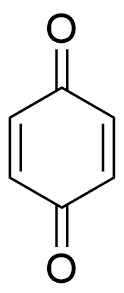p-Benzoquinone is widely utilized in research focused on:
- Organic Synthesis: It serves as a key intermediate in the synthesis of various organic compounds, including dyes and pharmaceuticals, making it invaluable for chemists in drug development.
- Polymer Chemistry: This compound is used in the production of conductive polymers, which are essential in the electronics industry for applications like organic light-emitting diodes (OLEDs) and solar cells.
- Biochemistry: p-Benzoquinone plays a role in studying enzyme mechanisms and redox reactions, aiding researchers in understanding metabolic pathways and developing new biochemical assays.
- Analytical Chemistry: It is employed as a reagent in various analytical techniques, such as spectrophotometry, to detect and quantify other compounds, enhancing laboratory efficiency.
- Antimicrobial Applications: Due to its reactive nature, it has potential uses in developing antimicrobial agents, offering a promising avenue for research in healthcare and pharmaceuticals.
General Information
Properties
Safety and Regulations
Applications
p-Benzoquinone is widely utilized in research focused on:
- Organic Synthesis: It serves as a key intermediate in the synthesis of various organic compounds, including dyes and pharmaceuticals, making it invaluable for chemists in drug development.
- Polymer Chemistry: This compound is used in the production of conductive polymers, which are essential in the electronics industry for applications like organic light-emitting diodes (OLEDs) and solar cells.
- Biochemistry: p-Benzoquinone plays a role in studying enzyme mechanisms and redox reactions, aiding researchers in understanding metabolic pathways and developing new biochemical assays.
- Analytical Chemistry: It is employed as a reagent in various analytical techniques, such as spectrophotometry, to detect and quantify other compounds, enhancing laboratory efficiency.
- Antimicrobial Applications: Due to its reactive nature, it has potential uses in developing antimicrobial agents, offering a promising avenue for research in healthcare and pharmaceuticals.
Documents
Safety Data Sheets (SDS)
The SDS provides comprehensive safety information on handling, storage, and disposal of the product.
Product Specification (PS)
The PS provides a comprehensive breakdown of the product’s properties, including chemical composition, physical state, purity, and storage requirements. It also details acceptable quality ranges and the product's intended applications.
Certificates of Analysis (COA)
Search for Certificates of Analysis (COA) by entering the products Lot Number. Lot and Batch Numbers can be found on a product’s label following the words ‘Lot’ or ‘Batch’.
*Catalog Number
*Lot Number
Certificates Of Origin (COO)
This COO confirms the country where the product was manufactured, and also details the materials and components used in it and whether it is derived from natural, synthetic, or other specific sources. This certificate may be required for customs, trade, and regulatory compliance.
*Catalog Number
*Lot Number
Safety Data Sheets (SDS)
The SDS provides comprehensive safety information on handling, storage, and disposal of the product.
DownloadProduct Specification (PS)
The PS provides a comprehensive breakdown of the product’s properties, including chemical composition, physical state, purity, and storage requirements. It also details acceptable quality ranges and the product's intended applications.
DownloadCertificates of Analysis (COA)
Search for Certificates of Analysis (COA) by entering the products Lot Number. Lot and Batch Numbers can be found on a product’s label following the words ‘Lot’ or ‘Batch’.
*Catalog Number
*Lot Number
Certificates Of Origin (COO)
This COO confirms the country where the product was manufactured, and also details the materials and components used in it and whether it is derived from natural, synthetic, or other specific sources. This certificate may be required for customs, trade, and regulatory compliance.


